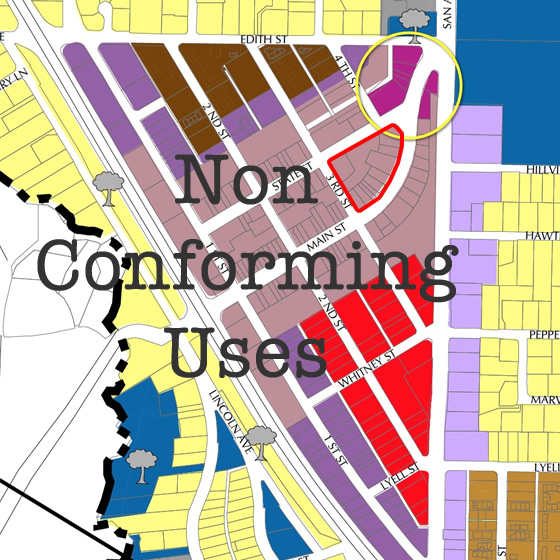Introduction
This morning Los Altos retail was under the City microscope again. The City Council ad hoc contiguous retail committee agreed to put aside scrutiny of banks downtown for now. Instead, under Ron Packard’s chairmanship, they moved on to start examining other non-conforming ground floor uses: law offices, travel agencies, fraternal orders. The committee agreed that the area of interest in the CRS zone, the area with retail “dead zones” and low foot traffic was the triangle formed by Main-State-First. Packard indicated that except for the Main Street Café and the Round Robin dress shop all other ground floor uses in that triangle are non-conforming non-retail uses according to current zoning code…or could be soon.
Attendees
Visitors to the meeting included three ladies from the Costume Bank and commercial real estate agent Mary Prochow, who happens to own a conforming(?) building just up from the Main Street Café. Mary spoke up several times during the meeting. A couple of residents observed.
Is Rental Retail?
It seems that the current zoning code is “nebulous” about the Costume Bank – a costume rental non-profit business – owned and operated by the Assistance League. Kathy Kleinbaun, City Economic Development Manager said, “They do charge sales tax on their rentals.” City Attorney Jolie Houston said in section 14.48.30 it is unclear if rental is retail. After more discussion she said, “If we want to say rental isn’t a retail use, we’d have to amend our code.” Ron said, “We ought to amend the code, one way or the other. Because it is nebulous. We ought to make it clear whether rental is retail or not. And if it is retail, what type of rental is retail, and what type is not. “
The City Attorney related, “The planning department brought up the idea of a bike store. If they rented some bikes, would that be a use we wanted to encourage or discourage? Sports stores that sell skis or skateboards, they usually rent also… Rental is a good source of income and a community benefit.”
Ron Packard said, “Salons claimed they were retail because they had a little display cabinet with some products.” Jolie said, “ We had that problem with the Martial Arts, [on State Street] where it became a classroom, where the services overtook the sales. We could have a better definition in our code.”
Mary Prochow asked, “ so If Selix Rentals came, and wanted to rent tuxedos and fine dresses to high school students, and they wanted to take a space on State Street, they would not be allowed, I’m asking now as I leasing agent. Would we send them away?”
Mary Prochow continued, “When you are trying to create a zoning code based on trying to accomplish one goal with one building [the Costume Bank], generally you end up with a very difficult to interpret zoning code as we have now. It becomes so convoluted that as professional [real estate commercial leasing agent] I can’t tell anyone what they can do anymore.”
Councilor and Committee member Jarrett Fishpaw addressing Mary Prochow, “We could say the percent of area that the Costume Bank uses is called Retail. Would that be difficult to apply to other businesses?”
Mary Prochow replied, “ You’d have to write into the code what that percentage is… what purpose does that serve?…Generally what I see in codes is that there is a circumstance, the councilor, the planning commission reacts to the circumstance, they layer on the code, and then we get something that is impossible to interpret. By anyone – you guys, the people who want to come to town. I’m saying, if you are following that scenario where you are going to leave the costume bank alone, then we don’t need this anymore. …What’s the purpose? We wouldn’t care would we? If this were not an issue that had been raised with the thought of saying they [Costume Bank] were not retail, and they’ve been here for as long as they’ve been [the 1960’s]…and I’ve never had the issue come up before [in forty years]….To me it looks like another thing that would just bog down the codes. And it you are not going to give them a difficulty, what’s the purpose?”
Ron Packard, “If we came up with a definition [of retail rental] either on floor area, or on revenue…if we were to change it… it would be clear that they [Costume Bank] are non-conforming…then if adopt some amortization, then that would apply to them, even though they are grandfathered in, be grandfathered no longer [inaudibly] after that amortization period.”
Committee member Scott Richies(?), “So that would serve a purpose.”
Lalapolitico: Yes, it serves the purpose of making the Assitance League vacate the building they own. They would probably be inclined to sell it we suppose. Hmmmm. Who wants to buy this?
A Fraternal Order or a Religion?
The group went on to discuss the Masonic temple. The building used to be church; it serves about 70 to 80 members; there are offices and fraternal rooms on the ground floor. In the current zoning code it is classified as a club, a fraternal order, and that use is permitted only on upper floors. Ron Packard went on to explain his vision of how the planter area and set back of the building from the sidewalk could be converted to “shallow retail.” Though he wasn’t sure if that kind of shop could be successful in Los Altos.
Lalapolitico: That sounds like an expensive conversion, with high risk, and limited chance of financial success. Mary Prochow was probably thinking along the same lines when she asked, “Are there block grants available to…. make it [Masonic Temple] more ground level friendly?” It turned out, no, not anymore. Ron Packard admitted, “The type of change we are talking about is painful.”
Fun with Amortization
The committee moved on to the topic of “amortization” ordinances. Their binder, which the public did not see, contained an example ordinance from an unspecified city. The City of Los Atos doesn’t yet have a zoning ordinance for “amortization.” One of the purposes of the committee is to consider crafting one.
Amortization is a giving notice of anywhere from 4 to 8 years to a business and property owner that their use will no longer be permitted.
Ron Packard explained the amortization was only being considered for uses, not for buildings. “I don’t think we can say to the Masonic Hall or the bank that you’ve got to tear that building down and rebuild conforming. That’s a dramatic step that I don’t think, ah, is rarely legal. Nor would you want to do that. The cost is just too great. But you can say that use in that building is non-conforming and you can’t use that building anymore for that particular use. The property owner may say, ‘To get a tenant, I may have to make some changes,’ but that is between the land owner and the future tenant who covers what changes, what costs, and who shares them. “
The city attorney explained that a proper amortization ordinance would 1) adopt a “reasonable” period of years such that a business and property owner could recoup their investments and, 2) include an appeal process that allows a business to argue the period is not long enough to recoup. The key trick is to have a “reasonable” period to avoid litigation around “takings.” The attorney thought that at some point, they might need to retain an economist to value businesses and to come up with the “reasonable” period. Valuing real property was seen as easy by comparison.
Plans for the Next Meeting in 2 Weeks
The committee made plans for the next meeting and handed out assignments. The direction was to pursue persuasion and amicable informal outreach. Member Deb Hope volunteered to get in contact with the property owners of the Bank of the West Building. (Packard mentioned he would like the owner to perhaps sublet the Drive-Thru to the City.) Council member, Jarrett Fishpaw volunteered to talk to the couple running the travel agency business. Scott Riches volunteered to talk to the owner of the Law Office Building (For Sale – agent is Mary Prochow). Ron Packard said that he would invite the leadership of the Masonic Temple to the next meeting.
So the next meeting should be a gathering of all the non-conforming users, except the banks.
LALAHPOLITICO EDITORIAL COMMENT:
We were glad to get the clarification that the non-conforming buildings wider than 25 feet are not a target of amortization, just the use for banking is a target. After all, the two corner bank buildings are arguably the best looking buildings downtown. Wow, real architecture instead of the ticky, tacky pre-war boxes that predominate.
Now the bad news. The City is acting like it’s a mall owner here. Yes, the bank drive-thru is a dead zone, and it would be nice if a shop sprang up there instead. [Mr. Packard, what would the City do with a sublet of the drive through?!] Yes, we admit a new retail mix, even in the too old, too small buildings of this targeted triangle of the CRS zone could be helpful in boosting foot traffic in the triangle and could probably create some positive spillover effects for the rest of the CRS zone. But who loses and who wins? This is very much a redistribution of benefits.
Targeted businesses are being “asked” to move before they want to – the city expects them to bear the moving costs, the temporary loss of business revenue, and perhaps permanent loss of business expected revenue if the new location is not a good substitute. The City offers them no relocation help, monetary or otherwise. Economists would say the fair thing to do is to offer them a one-time lump sum side payment to move. Lawyers say, get a lawyer.
But it’s worse. If “amortization” is applied to “uses” in this triangle, won’t it be applied throughout CRS? Very disruptive and costly to a lot of lessees and lessors. There are twin clouds hanging over downtown now. One is this cloud of “amortization” and the other is the pending rollback of 30 foot height limit for the CRS zone. We think leasing space in CRS or selling property in the CRS just got a lot harder. Just the talk of this encumbrance stuff is killing value.







